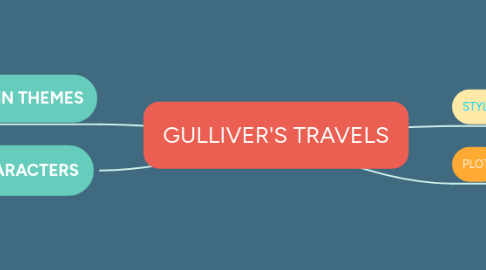
1. MAIN THEMES
1.1. SATIRE
1.1.1. Gulliver’s Travels reflects conflicts in British society in the early 18th century. By narrating Gulliver’s adventures in Lilliput, Brobdingnag, Laputa, and Houyhnhnm, the novel reveals and criticizes sins and corruption of British ruling class and their cruel exploitation towards people of Britain and neighboring countries in the capital-accumulation period of British history.
1.1.2. VERBAL IRONY: using words in an opposite way. It uses positive, laudatory words to describe evidently ugly and obnoxious matters in order to express the author’s contempt and aversion
1.1.3. SITUATIONAL IRONY: It occurs when there are conflicts between characters and situation, or contradiction between readers’ expectation and actual outcomes of an event, or deviation between personal endeavors and objective facts.
1.1.4. DRAMATIC IRONY: when words and actions possess a significance that the listener or audience understands, but the speaker or character does not.
1.1.5. CONTRASTING SUBJECTS: he puts contradictory subjects together to describe and compare.
1.2. MIGHT VERSUS RIGHT
1.2.1. Gulliver’s Travels implicitly poses the question of whether physical power or moral righteousness should be the governing factor in social life. Gulliver experiences the advantages of physical might both as one who has it, as a giant in Lilliput where he can defeat the Blefuscudian navy by virtue of his immense size, and as one who does not have it, as a miniature visitor to Brobdingnag where he is harassed by the hugeness of everything from insects to household pets.
1.3. THE INDIVIDUAL VS SOCIETY
1.3.1. Gulliver’s Travels explores the idea of utopia—an imaginary model of the ideal community. Swift's attitude towards utopia is much more skeptical, and one of the main aspects he points out about famous historical utopias is the tendency to privilege the collective group over the individual.
1.4. THE LIMITS OF HUMAN UNDERSTANDING
1.4.1. Swift insists that there is a realm of understanding into which humans are simply not supposed to venture.
1.4.2. Practical knowledge is satirized when it does not produce results
1.4.3. His portrait of the disagreeable and self-centered Laputans, who show blatant contempt for those who are not sunk in private theorizing, is a clear satire against those who pride themselves on knowledge above all else.
2. CHARACTERS
2.1. Lilliputians And Blefuscudians
2.1.1. Two races of miniature people whom Gulliver meets on his first voyage. Lilliputians and Blefuscudians are prone to conspiracies and jealousies, and while they treat Gulliver well enough materially, they are quick to take advantage of him in political intrigues of various sorts. The two races have been in a longstanding war with each over the interpretation of a reference in their common holy scripture to the proper way to eat eggs.
2.2. Laputans
2.2.1. Absentminded intellectuals who live on the floating island of Laputa, encountered by Gulliver on his third voyage. The Laputans are parodies of theoreticians, who have scant regard for any practical results of their own research.
2.3. Yahoos
2.3.1. Unkempt humanlike beasts who live in servitude to the Houyhnhnms. Yahoos seem to belong to various ethnic groups, since there are blond Yahoos as well as dark-haired and redheaded ones.
2.4. Houyhnhnms
2.4.1. Rational horses who maintain a simple, peaceful society governed by reason and truthfulness—they do not even have a word for “lie” in their language. Houyhnhnms are like ordinary horses, except that they are highly intelligent and deeply wise.
3. STYLE
3.1. Swift declares that "the style is very plain and simple", however the novel's dense mixture of fantasy, political satire, moral fable and playfulness renders it a highly complex works. He records every single detail in the language of the traveller who speaks with great seriousness. Many regarded it as a misanthropic book, while others just a satire of man's hypocrisy.
4. PLOT
4.1. First journey: Lilliput.
4.1.1. Description: it’s an island where the inhabitants are called Lilliputians. They are tiny people. He learns about their culture and helps them in their war against Blefuscu.
4.1.1.1. Interpretations: the Lilliputians represent cruelty, pettiness and provincialism, and see Gulliver just as a means to destroy their enemies.
4.2. Second journey: Brobdingnag
4.2.1. Description: it’s an island where the inhabitants are giants. They sell Gulliver to the queen, he has some discussions with the king about the political situation in Europe and returns to England.
4.2.2. Interpretations: the giants represent human vanity and self-love. He feels disgust towards the human body, seeing it as an obstacle to spiritual growth. He now is able to see how the Lilliputians saw him.
4.3. Third journey: Laputa
4.3.1. Description: it’s a flying island whose capital is called Lagado. It’s populated by philosophers and scientists involved in futile research and speculations. Some of this inventions anticipate future developments.
4.3.2. Interpretations: Laputians can be seen as a parody of the pretensions of abstract intellectual thinking and as a satire on England’s military ambitions. From a distance, however, Laputa is also a world of lightness and freedom.
4.4. Fourth journey: Houyhnhnms
4.4.1. Description: it’s a land ruled by intelligent horses whose names are the same as the land’s. They are served by Yahoos, a filthy subhuman race. Gulliver tries to learn the language and the ways of the inhabitants. He integrates himself so well that when he returns to his family, he’s disgusted by their humanness.
4.4.2. Interpretations: it’s one of the best examples of Swiftian reversals. We see Gulliver by the horses’ perspective, who think that he’s a Yahoo. He tries to convince them otherwise, only making him believe that humans are just like Yahoos, only a bit more barbaric.
